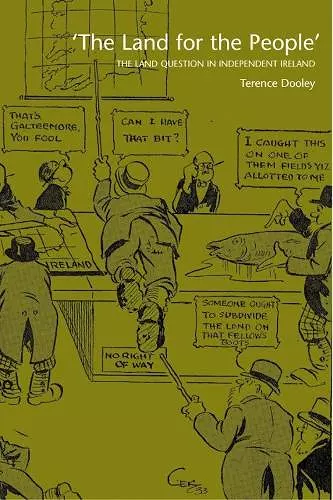The Land for the People
Format:Hardback
Publisher:University College Dublin Press
Published:9th Jul '04
Currently unavailable, our supplier has not provided us a restock date

While the land question from the mid-Victorian period to the eve of the First World War plays a prominent role in Irish historiography, historians have tended to overlook its importance in post-independence Ireland and have generally assumed that there was no land question after 1922. Terence Dooley debunks this myth. In this first systematic analysis of the land question in independent Ireland, he contends that agrarian agitation proved to be an important stimulus to political revolution during the period 1917 to 1923. He assesses the dangers which agitation posed for the Provisional Government after 1922 and argues that the 1923 Land Act not only ended agrarian agitation but also made a major contribution to ending the Civil War. Dooley emphasises the significance of Irish Land Commission to Irish rural life in an extensive analysis of the working of the Land Commission after its reconstitution in 1923. The commission became the most important (and controversial) government body operating in independent Ireland. It acted as a facilitator of social engineering, compulsorily acquiring lands from traditional landlords, large farmers, graziers and negligent farmers and passing them on to smallholders, ex-employees of acquired estates, evicted tenants and their representatives, members of the pre-Truce IRA and the landless. It migrated over 14,500 farmers onto lands totalling almost 400,000 acres. The continued hunger for land and the impact of land acquisition and division on so many people ensured that the land reform question remained one of the most potent political issues until the early 1980s.
"Dooley has an eye for the ridiculous as well as for the significant. He does the topic glorious justice, illustrating by his wide-ranging trawl through the subject that melodramatic goings-on in public life are just as dramatic as any play peopled by characters such as John B Keane's Bull, who lives in every parish throughout the nation." Irish Independent August 2004 "Written in a highly readable style, this book gives a very useful insight into the Irish land question and provides a useful template for further local studies that the author hopes his work will serve to stimulate." Limerick Leader July 2004 "Maynooth historian Dooley shows that the land question that contributed so much to achieving independence remained very much alive thereafter ... Statistics and a few maps and a text claimed to be approachable by the general reader." Books Ireland Sept 2004 "Anyone interested in their roots, in the roots of much of the rural social fabric of today in Kildare, and in the traditional values imposed on so many will enjoy this expansive, articulate work." Leinster Leader Nov 2004 "Dr Terence Dooley has made a significant contribution to our understanding of Ireland's social and economic development. It is highly recommended." Tipperary Historical Journal 2005 "While historians, along with English literature compatriots, dissect the writings of James Joyce and William Butler Yeats to find convenient metaphors for explaining Ireland's past, the book by Terence Dooley goes to the heart of the matter and presents a workmanlike account of how 'independent Ireland's' most important asset, its land, was redistributed and reorganised." Irish Economic and Social History 2005 "a most worthwhile and illuminating study. Its style is lucid, it presents the complexities of the land question in a clear but not simplistic manner, and, by using a wide range of sources including government department records and reports, personal papers, legislation, newspapers and oral evidence, it opens up an area of research hitherto relatively neglected." Irish Studies Review 14 (4) 2006 "[Dooley's] book usefully 'challenges the widely held orthodoxy that there was no land question in independent Ireland'." Economic History Review, Feb 2007
ISBN: 9781904558149
Dimensions: unknown
Weight: unknown
304 pages